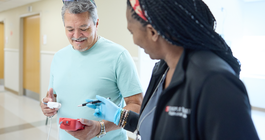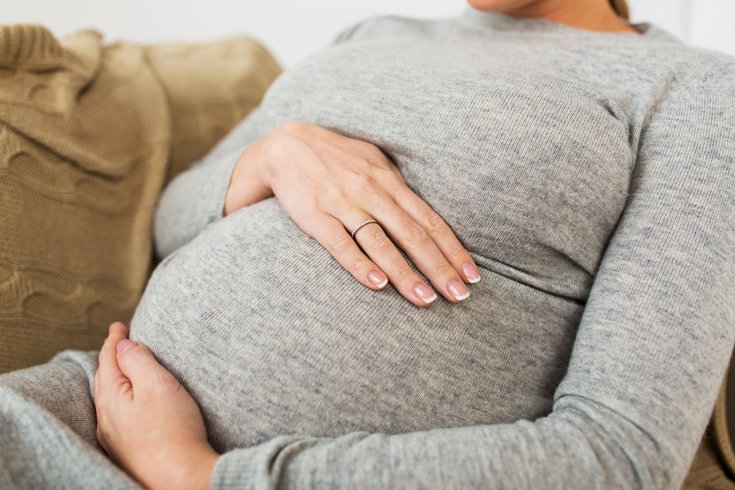
July 04, 2023
 Source/Image licensed from Ingram Image
Source/Image licensed from Ingram Image
A new federal requires employers to provide reasonable accommodations to those who are pregnant. But public health experts say not nearly enough is known about which work circumstances are dangerous for pregnancies.
Vanessa Langness had always been a bit worried about the chemicals she worked with as a biomedical researcher, but when she got pregnant in October, her concerns grew. The 34-year-old based in Santa Maria, California, suspected the ethidium bromide she was using in the lab for molecular cloning could put her and her baby at risk.
She wasn't sure what to do; she was only a few weeks into her pregnancy and didn't know how it would affect her career.
"Women are taught: You aren't supposed to tell people until after the first trimester," she said. "But that's actually a really delicate stage for the formation of the baby."
Langness did some research online but couldn't find much information on what kind of extra precautions she should take because of her pregnancy. Without realizing it, she had stumbled upon an often overlooked area of science and medicine: the occupational health of pregnant workers. Those who are pregnant often face hazardous circumstances doing jobs in which they must lift heavy objects, stand for long periods, or, like Langness, work with chemicals.
At the end of last year, Congress approved the Pregnant Workers Fairness Act, a law that requires employers to provide "reasonable accommodations" to those who are pregnant. But the new law, which took effect June 27, has a big hole in it: Public health experts say not nearly enough is known about which work circumstances are dangerous for pregnancies, especially when chemical exposures are involved. That's because occupational health studies overwhelmingly have been centered on men, and so have the health and safety standards based on those studies.
"A pregnant person's physiology is very different from a nonpregnant person," said Carissa Rocheleau, an epidemiologist at the National Institute for Occupational Safety and Health. "A lot of our existing permissible exposure limits date back to 1970. In the studies they based the limits on, there were very few women in general and even fewer pregnant women, if any."
The American College of Obstetricians and Gynecologists' guidance for employment considerations during pregnancy says that very few chemical compounds "have been sufficiently studied to draw conclusions about potential reproductive harms."
Even though the data is sparse, several physiological factors suggest pregnant workers face higher health risks from chemical exposures than other adults, said Julia Varshavsky, a Northeastern University environmental health scientist focused on maternal and child health. And chemical exposures during pregnancy can be dangerous not just for the prospective parent, but also for the fetus, which can absorb toxins through the placenta.
For one thing, blood volume increases during pregnancy because the body is working overtime to supply the fetus with the oxygen and nutrients it needs to develop. Such blood-flow expansion can make those who are pregnant susceptible to developing high blood pressure. Some studies also suggest a link between exposure to lead during pregnancy and high blood pressure.
Pregnancy also considerably alters a person's metabolism; the body prioritizes breaking down fats instead of sugars to preserve the sugar for the developing fetus. Especially after the first trimester, those who are pregnant have high blood sugar and must double their insulin production to keep it under control. It's risky for them to be exposed to chemicals such as PFAS that have been linked to insulin resistance, a condition in which cells don't respond to insulin anymore.
Finally, those who are pregnant are also especially susceptible to a category of chemicals known as endocrine disruptors. Estrogen is the hormone responsible for promoting the body's changes during pregnancy. When endocrine disruptors enter the body, they mimic those hormones and can increase the risk of certain pregnancy-related health conditions, such as preeclampsia.
But despite these known risks, the occupational health of pregnant women has often been understudied, especially as women have entered more diverse areas of work.
"Occupational health really assumes a neutral body worker," said Swati Rayasam, a public health scientist at the Program on Reproductive Health and the Environment at the University of California-San Francisco. By concentrating on this "neutral body worker," occupational health as a field has overlooked the other stressors workers can face, either internal stressors, such as pregnancy, or external stressors, such as psychosocial stress due to racism or food insecurity, Rayasam said.
It also is tough to study those who are pregnant. It is unethical to expose them to even the slightest amount of chemicals, so research protocols are highly restricted. And very few occupational health surveys include enough pregnant workers to draw reliable conclusions about the unique risks they face.
Langness, the biomedical researcher in California, had a miscarriage while working in the lab. She later decided to change jobs, although she doesn't know if the chemicals had anything to do with the loss of the baby.
The lack of research doesn't affect only current pregnancies but also leaves women who have already been exposed with lots of questions. They include Leticia Mendoza, a 38-year-old woman who lives in Oakland, California. She said she was exposed to pesticides when she worked pruning strawberries while pregnant. When her baby was born, he did not crawl until he was 1 year old and started walking after he turned 2.
"I thought he was going to start talking when he was 3, but he still doesn't, and he is 5," Mendoza said.
Mendoza's child has been diagnosed with autism.
Although researchers have studied potential links between pesticide exposure and neurodevelopmental disorders, the evidence is not conclusive, which complicates proving in a court what caused the harm, said Sharon Sagiv, an associate adjunct professor in environmental epidemiology at the University of California-Berkeley.
Advocates hope the new federal law will give workers a little more leverage when they raise concerns about risks on the job. "We really just want them to be able to have a conversation with their employer without facing retaliation or being forced on unpaid leave," said Kameron Dawson, a senior staff attorney for A Better Balance, a workers' advocacy organization that pushed for the Pregnant Workers Fairness Act for over a decade.
But although some of the regulations might lead to better accommodations for pregnant workers, that depends partly on the employer or a union knowing what can represent a risk. "It's not rocket science, but it does take effort on the employer's side to understand what in their workplace could be hazardous," said Gillian Thomas, a senior staff attorney at the American Civil Liberties Union.
In the past, women have sometimes been forbidden from working while pregnant, so a delicate balance must be struck between protecting them and their pregnancies and not removing them from the workforce. "It's tricky because, for many women, this is their livelihood," said Sagiv.
Some researchers believe studying the enhanced risks faced in pregnancy may result in more protective regulations that would help the wider public.
"If we really try to protect the most vulnerable workers in the workplace, we're protecting everybody," Rocheleau said.